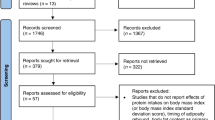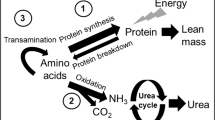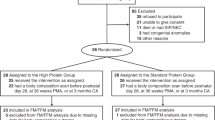Abstract
It has been argued that the growth rate of exclusively breast-fed infants may be limited by their protein intake. This issue was examined using data from an intervention study in Honduras in which infants were randomly assigned to be exclusively breast-fed for the first 6 mo (EBF; n = 50), or to receive preprepared solid foods (including egg yolk) in addition to breast milk beginning at 4 mo (n = 91). Neither weight gain nor length gain from 4 to 6 mo differed between groups despite a 20% higher protein intake (as well as significantly higher intakes of iron, zinc, calcium, vitamin A, and riboflavine) in the latter group. The 20 infants with the highest protein intakes in that group were matched to 20 EBF infants on the basis of energy intake; protein intake was 1.46 ± 0.09 versus 1.10 ± 0.17 g/kg/d, respectively (p < 0.001), but growth rate did not differ between groups. Similarly, the 20 infants with the lowest protein intakes in the EBF group were matched (by energy intake) to 20 infants given solid foods; protein intake was very low in the former compared with the latter (0.81 ± 0.13 versus 1.04 ± 0.20 g/kg/d;p < 0.001), yet there was still no difference in growth. Infant morbidity was relatively low and did not influence the results. These analyses indicate that protein intake is not likely to be a limiting factor with regard to growth of breast-fed infants from 4 to 6 mo of age.
Similar content being viewed by others
Log in or create a free account to read this content
Gain free access to this article, as well as selected content from this journal and more on nature.com
or
Abbreviations
- EBF:
-
exclusively breast-fed
- SF:
-
solid food
- SF-M:
-
solid food with maintenance of breast-feeding frequency
References
Fomon SJ 1993 Nutrition of Normal Infants. Mosby-Year Book, St. Louis, pp 121–139
Dewey KG, Heinig MJ, Nommsen LA, Peerson JM, Lonnerdal B 1992 Growth of breast-fed and formula-fed infants from 0 to 18 months: the DARLING study. Pediatrics 89: 1035–1041
Duncan B, Schaefer C, Sibley B, Fonseca NM 1984 Reduced growth velocity in exclusively breast-fed infants. Am J Dis Child 138: 309–313
Salmenpera L, Perheentupa J, Siimes M 1985 Exclusively breast-fed healthy infants grow slower than reference infants. Pediatr Res 19: 307–312
Axelsson IE, Jakobsson I, Raiha NCR 1988 Formula with reduced protein content: effects on growth and protein metabolism during weaning. Pediatr Res 24: 297–301
Heinig MJ, Nommsen LA, Peerson JM, Lonnerdal B, Dewey KG 1993 Energy and protein intakes of breast-fed and formula-fed infants during the first year of life and their association with growth velocity: the DARLING study. Am J Clin Nutr 58: 152–161
Cohen RJ, Brown KH, Canahuati J, Landa Rivera L, Dewey KG 1994 Effects of age of introduction of complementary foods on infant breast milk intake, total energy intake and growth: a randomized intervention study in Honduras. Lancet 344: 288–293
Food and Nutrition Board. 1989 Recommended Dietary Allowances. National Academy Press, Washington, DC
Nommsen LA, Lovelady CA, Heinig MJ, Lonnerdal B, Dewey KG 1991 Determinants of energy, protein, lipid, and lactose concentrations in human milk during the first 12 mo of lactation: the DARLING study. Am J Clin Nutr 53: 457–465
Folch J, Lees M, Sloan SGH 1957 A simple method for the isolation and purification of total lipids from animal tissue. J Biol Chem 226: 497–509
Hambraeus L, Forsum E, Abrahamsson L, Lonnerdal B 1976 Automatic total nitrogen analysis in nutritional evaluations using a block digestor. Anal Biochem 72: 78–85
Dahlqvist A 1964 Method for assay of intestinal disaccharidases. Anal Biochem 7: 18–25
Garza C, Butte NF, Dewey KG 1985 Determination of the energy content of human milk. In: Jensen RG, Neville MC (eds) Human Lactation. I. Milk Components and Methodologies. Plenum Press, New York, pp 121–125
Institute of Medicine 1991 Nutrition during Lactation. National Academy Press, Washington, DC, p 116
Dewey KG, Lonnerdal B 1983 Milk and nutrient intake of breast-fed infants from 1 to 6 months: relation to growth and fatness. J Pediatr Gastroenterol Nutr 2: 497–506
Perez-Escamilla R, Cohen RJ, Brown KH, Landa Rivera L, Canahuati J, Dewey KG . 1995 Maternal anthropometric status and lactation performance in a low-income Honduran population: evidence for the role of infants. Am J Clin Nutr 61: 528–534
Cohen RC, Brown KH, Canahuati J, Landa Rivera L, Dewey KG . 1995 Determinants of growth from birth to 12 months among breast-fed Honduran infants in relation to age of introduction of complementary foods. Pediatrics 96: 504–510
Stuff JE, Nichols BL 1989 Nutrient intake and growth performance of older infants fed human milk. J Pediatr 115: 959–968
Bell JG, Keen CL, Lonnerdal B 1987 Effect of infant cereals on zinc and copper absorption during weaning. Am J Dis Child 141: 1128–1132
Oski FA, Landaw SA 1980 Inhibition of iron absorption from human milk by baby food. Am J Dis Child 134: 459–460
Ellis R, Kelsay JL, Reynolds RD, Morris ER, Moser PB, Frazier CW 1987 Phytate: zinc and phytate calcium:zinc millimolar ratios in self-selected diets of Americans, Asian Indians, and Nepalese. J Am Diet Assoc 87: 1043–1047
Sandstrom B, Davidsson L, Cederblad A, Lonnerdal B 1985 Oral iron, dietary ligands and zinc absorption. J Nutr 115: 411–414
Haschke F, Ziegler EE, Edwards BB, Fomon SJ 1986 Effect of iron fortification of infant formula on trace mineral absorption. J Pediatr Gastroenterol Nutr 5: 768–773
Acknowledgements
We are grateful to the Honduran research team for their dedicated work on the project, to the La Leche League/Honduras staff and the Ministry of Health/Honduras for their cooperation, and to the mothers of San Pedro Sula for their willingness to participate in the study. Rafael Perez-Escamilla and Laurie Rivers provided invaluable assistance in analyzing the milk samples.
Author information
Authors and Affiliations
Additional information
Supported jointly by the Thrasher Research Fund; the World Health Organization; UNICEF/Honduras; and the Institute for Reproductive Health(formerly the Institute for International Studies in Natural Family Planning), Georgetown University, under a Cooperative Agreement with the United States Agency for International Development (A.I.D.) (DPE-3040-A-00-5064-00 and DPE-3061-A-00-1029-00). The views expressed by the authors do not necessarily reflect the views of these institutions. Complementary foods were provided at reduced cost by Gerber Products Company.
Rights and permissions
About this article
Cite this article
Dewey, K., Cohen, R., Rivera, L. et al. Do Exclusively Breast-Fed Infants Require Extra Protein?. Pediatr Res 39, 303–307 (1996). https://doi.org/10.1203/00006450-199602000-00019
Received:
Accepted:
Issue date:
DOI: https://doi.org/10.1203/00006450-199602000-00019



